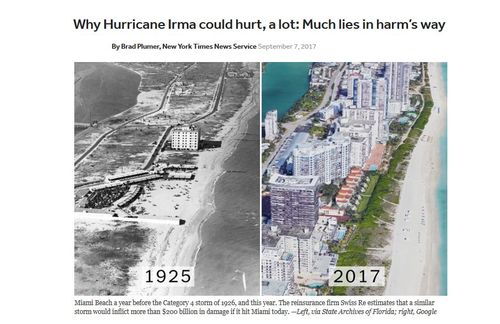As the powerful Hurricane Irma moves toward Florida, climate change is already being named as the culprit for the storm’s projected level of damage. But we needn’t look beyond the state’s rapid population growth and corresponding construction to understand the escalating cost of big storms there.
![]()
Florida is one America’s top five states for immigration-caused population growth:
Frequently Requested Statistics on Immigrants and Immigration in the United States, Migration Policy, March 8, 2017Immigrant Population Change over Time: Top States
What were the top five states in terms of the number of immigrants, share of immigrants in the total state population, absolute growth, and percent growth between 1990 and 2000 and between 2000 and 2015?
In 2015, the top five U.S. states by number of immigrants were California (10.7 million), Texas (4.7 million), New York (4.5 million), Florida (4.1 million), and New Jersey (close to 2 million).
When classified by the share of immigrants out of the total state population, the top five states in 2015 were California (27 percent), New York (23 percent), New Jersey (22 percent), Florida (20 percent), and Nevada (19 percent).
Between 1990 and 2000, the five states with the largest absolute growth of the immigrant population were California (2.4 million), Texas (1.4 million), New York (1 million), Florida (1 million), and Illinois (577,000).
Between 2000 and 2015, the five states with the largest absolute growth of the immigrant population were California and Texas (1.8 million each), Florida (1.4 million), New York (662,000), and New Jersey (501,000).
![]()
Another factor in Florida’s rapid growth is taxpayer-subsidized property insurance that protects home owners from the real cost of building in such a hazardous region.
Why Hurricane Irma could hurt, a lot: Much lies in harm’s way, New York Times News Service, September 7, 2017WASHINGTON — The last time a Category 5 hurricane ripped through Florida, it was so destructive that meteorologists retired its name forever. That storm, Hurricane Andrew, made landfall southwest of Miami in 1992, killing 65 people, destroying 63,000 homes and inflicting $26.5 billion in economic losses.
But if a similar-sized hurricane were to strike Florida today in the same spot, it would be far more catastrophic — causing up to $100 billion in damage, according to a recent analysis by Swiss Re, the reinsurance firm. That is even after accounting for the fact that South Florida has strengthened its building codes since Andrew.
The reason is simple: Central and South Florida have grown at a breathtaking pace since 1990, adding more than 6 million people. Glittering high-rises and condominiums keep sprouting up along Miami Beach and other coastal areas. A lot more valuable property now sits in harm’s way.
With Hurricane Irma — currently a Category 5 storm and one of the strongest hurricanes ever recorded in the Atlantic — possibly set to pummel Florida this weekend, the state is confronting the fact that rapid development has made its coastline far more vulnerable to hurricane damage than it used to be.
“Florida has exploded in the last 40 years,” said Megan Linkin, a natural hazards expert at Swiss Re. “If you look at images of Miami Beach from 1926” — when the Great Miami Hurricane, a Category 4 storm, devastated the city with a direct hit — “it’s almost unrecognizable today.”
(Continues)















